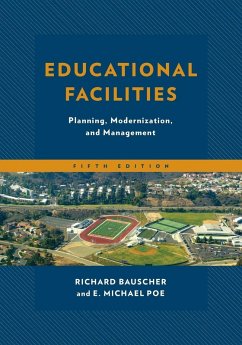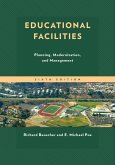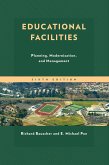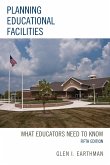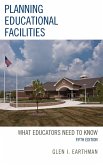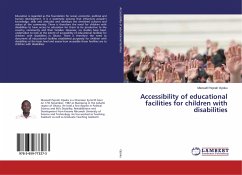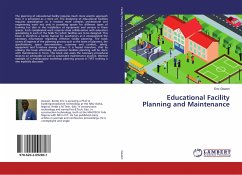- Broschiertes Buch
- Merkliste
- Auf die Merkliste
- Bewerten Bewerten
- Teilen
- Produkt teilen
- Produkterinnerung
- Produkterinnerung
This fifth edition is the most comprehensive and up-to-date book on the market today in the planning of educational facilities.
Andere Kunden interessierten sich auch für
![Educational Facilities Educational Facilities]() Richard BauscherEducational Facilities40,99 €
Richard BauscherEducational Facilities40,99 €![Educational Facilities Educational Facilities]() Richard BauscherEducational Facilities101,99 €
Richard BauscherEducational Facilities101,99 €![Planning Educational Facilities Planning Educational Facilities]() Glen I. EarthmanPlanning Educational Facilities67,99 €
Glen I. EarthmanPlanning Educational Facilities67,99 €![Planning Educational Facilities Planning Educational Facilities]() Glen I. EarthmanPlanning Educational Facilities125,99 €
Glen I. EarthmanPlanning Educational Facilities125,99 €![Accessibility of educational facilities for children with disabilities Accessibility of educational facilities for children with disabilities]() Maxwell Peprah OpokuAccessibility of educational facilities for children with disabilities36,99 €
Maxwell Peprah OpokuAccessibility of educational facilities for children with disabilities36,99 €![Educational Facility Planning and Maintenance Educational Facility Planning and Maintenance]() Eric GowonEducational Facility Planning and Maintenance36,99 €
Eric GowonEducational Facility Planning and Maintenance36,99 €![Sounding the Alarm in the Schoolhouse Sounding the Alarm in the Schoolhouse]() Nicholas D. YoungSounding the Alarm in the Schoolhouse42,99 €
Nicholas D. YoungSounding the Alarm in the Schoolhouse42,99 €-
-
-
This fifth edition is the most comprehensive and up-to-date book on the market today in the planning of educational facilities.
Hinweis: Dieser Artikel kann nur an eine deutsche Lieferadresse ausgeliefert werden.
Hinweis: Dieser Artikel kann nur an eine deutsche Lieferadresse ausgeliefert werden.
Produktdetails
- Produktdetails
- Verlag: Rowman & Littlefield Publishers
- 5th Edition
- Seitenzahl: 292
- Erscheinungstermin: 9. Januar 2018
- Englisch
- Abmessung: 254mm x 178mm x 16mm
- Gewicht: 554g
- ISBN-13: 9781475830057
- ISBN-10: 147583005X
- Artikelnr.: 49446202
- Herstellerkennzeichnung
- Libri GmbH
- Europaallee 1
- 36244 Bad Hersfeld
- gpsr@libri.de
- Verlag: Rowman & Littlefield Publishers
- 5th Edition
- Seitenzahl: 292
- Erscheinungstermin: 9. Januar 2018
- Englisch
- Abmessung: 254mm x 178mm x 16mm
- Gewicht: 554g
- ISBN-13: 9781475830057
- ISBN-10: 147583005X
- Artikelnr.: 49446202
- Herstellerkennzeichnung
- Libri GmbH
- Europaallee 1
- 36244 Bad Hersfeld
- gpsr@libri.de
Dr. Richard Bauscher has been a school superintendent for 23 years as well as serving as an assistant superintendent in Washington, a principal and an athletic director in Idaho. He spent 8 years as a full time educational consultant working with architect firms, school districts, state departments and other state agencies in the northwestern states of Idaho, Montana, Oregon, Utah and Washington. Rich has currently assisted 63 school districts (1990-2017) in passing their levies with a 90% success rate [63 of 70 levies have passed] with an average passage rate of 73.9%. He has been involved for 15 years with the assessment of school facilities, as well as 30 years with many school construction projects including new buildings, remodels, additions and their respective designs. Rich is currently an Associate Professor in the Educational Leadership department for the University of Idaho and he remains as an educational consultant with his Facility Planners firm. Dr. Mike Poe has been an administrator for 35 years in a variety of settings including middle school, high school and university levels. He has been involved with numerous school construction projects including new buildings, remodels and additions. Mike is currently a Professor and the Program Director for Educational Leadership at Northwest Nazarene University in Nampa, Idaho.
Preface Part I: Theory and Principles of Planning Chapter 1: The Evolution
of Educational Facilities Chapter 2: Educational Practices and
Technological Developments Part II: Procedures and Criteria for Long-Range
Planning Chapter 3: School Surveys Chapter 4: The Building Condition
Evaluation Form [BCEF] and Long Range Plan Part II: Description of Special
Physical Features Part III: Fundamental Elements of Educational Planning
Chapter 6: Leeway for Change Chapter 7: Adequacy, Efficiency, and Economy
Chapter 8: Planning for Energy Conservation and Management Chapter 9:
Safety, Health, and Comfort Part IV: Planning an Education Facility Chapter
10: Planning Elementary and Middle Schools Chapter 11:Planning Secondary
School Buildings Chapter 12 Post-Planning Procedures and Construction Costs
Chapter 13: Modernization of Educational Facilities Chapter 14: School Bond
Referendums Appendix: Appendix I Bond Timeline Example Appendix II Bond
Brochure
of Educational Facilities Chapter 2: Educational Practices and
Technological Developments Part II: Procedures and Criteria for Long-Range
Planning Chapter 3: School Surveys Chapter 4: The Building Condition
Evaluation Form [BCEF] and Long Range Plan Part II: Description of Special
Physical Features Part III: Fundamental Elements of Educational Planning
Chapter 6: Leeway for Change Chapter 7: Adequacy, Efficiency, and Economy
Chapter 8: Planning for Energy Conservation and Management Chapter 9:
Safety, Health, and Comfort Part IV: Planning an Education Facility Chapter
10: Planning Elementary and Middle Schools Chapter 11:Planning Secondary
School Buildings Chapter 12 Post-Planning Procedures and Construction Costs
Chapter 13: Modernization of Educational Facilities Chapter 14: School Bond
Referendums Appendix: Appendix I Bond Timeline Example Appendix II Bond
Brochure
Preface Part I: Theory and Principles of Planning Chapter 1: The Evolution
of Educational Facilities Chapter 2: Educational Practices and
Technological Developments Part II: Procedures and Criteria for Long-Range
Planning Chapter 3: School Surveys Chapter 4: The Building Condition
Evaluation Form [BCEF] and Long Range Plan Part II: Description of Special
Physical Features Part III: Fundamental Elements of Educational Planning
Chapter 6: Leeway for Change Chapter 7: Adequacy, Efficiency, and Economy
Chapter 8: Planning for Energy Conservation and Management Chapter 9:
Safety, Health, and Comfort Part IV: Planning an Education Facility Chapter
10: Planning Elementary and Middle Schools Chapter 11:Planning Secondary
School Buildings Chapter 12 Post-Planning Procedures and Construction Costs
Chapter 13: Modernization of Educational Facilities Chapter 14: School Bond
Referendums Appendix: Appendix I Bond Timeline Example Appendix II Bond
Brochure
of Educational Facilities Chapter 2: Educational Practices and
Technological Developments Part II: Procedures and Criteria for Long-Range
Planning Chapter 3: School Surveys Chapter 4: The Building Condition
Evaluation Form [BCEF] and Long Range Plan Part II: Description of Special
Physical Features Part III: Fundamental Elements of Educational Planning
Chapter 6: Leeway for Change Chapter 7: Adequacy, Efficiency, and Economy
Chapter 8: Planning for Energy Conservation and Management Chapter 9:
Safety, Health, and Comfort Part IV: Planning an Education Facility Chapter
10: Planning Elementary and Middle Schools Chapter 11:Planning Secondary
School Buildings Chapter 12 Post-Planning Procedures and Construction Costs
Chapter 13: Modernization of Educational Facilities Chapter 14: School Bond
Referendums Appendix: Appendix I Bond Timeline Example Appendix II Bond
Brochure

